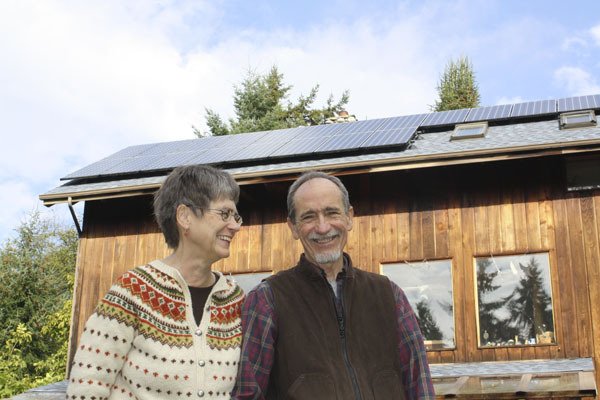For Jay and Rayna Holtz, installing a solar system on their Vashon house last October meant realizing a dream that began more than 30 years ago.
The couple, a U.S. postal worker (Jay) and a reference librarian (Rayna), moved to the Island in 1975. They designed their home so that it could one day be powered by the sun’s energy.
“I’ve always wanted solar,” said Jay. “But in 1980, $100,000 worth of solar produced one-tenth the power I was using. It wasn’t economical or affordable.”
Fast-forward to 2009, when more efficient products and financial incentives like tax rebates helped the Holtzes make the shift to solar.
“It’s a big initial expense — about $40,000,” admitted Jay. “But we got 30 percent back as a tax credit. For someone who is paying taxes — Rayna and I still work — it reduced last year’s federal taxes to nothing.”
And the numbers only got better from there. The Holtzes live in a 2,300-square-foot home, which they heat with wood. Puget Sound Energy (PSE) met all their other power needs to the tune of $100 per month. Since installing solar, their monthly bill has dropped to around $7.25. Based on that savings, the Holtzes figure they’ll recover the cost of their solar system in about 15 to 20 years. And that’s not counting one other bonus feature.
Each year, a check arrives from the power company. The amount is based on the difference between how much power the Holtzes generate and how much they use.
This is how it works: Their solar system is tied into PSE’s grid. When they consume more power than they produce, the Holtzes get the extra power — and the bill — from PSE. When they produce more than they consume, the excess power goes back into the grid and the Holtzes get a credit. If, at the end of the year, they generate more power than they consume, Jay and Rayna receive a check from PSE. This year, despite a less than sunny summer and the fact that their system had been on line for only 10 months, they made $500.
Jay and Rayna are strong proponents of sustainability, so when they decided to make the switch to solar, they looked for a local installer. After attending a workshop led by Jason Williams of Vashon’s Artisan Electric. they knew they had found their man.
“Installation went very fast,” said Jay. “A couple days of wiring set-up and a couple of days on the roof and it was done.”
The Holtzes’ house, with its southern exposure and sloped roof, was an ideal candidate for solar. That’s not true of every Vashon home. For those Islanders wondering about the feasibility of solar for their house, Artisan Electric has a handy assessment tool.
“Jason has a computer that takes a picture of the sky and tree line from the roof,” Jay said. “Then a program calculates the position of the sun over a year and produces a report on the potential efficiency of your system.”
Once a system is in place, a dedicated website allows homeowners to generate reports on the daily and lifetime production of each solar panel.
As soon as the Holtzes’ system started producing power, Jay started tracking the input and output of energy.
“I became even more fanatical about efficiency,” he said. “It became something of a game to see how much we could reduce our consumption. Looking at
the power meter really heightens your awareness of how much energy you consume.”
Financial incentives and efficiency aside, there’s one other aspect of solar power that attracted the Holtzes in 1980 and remains true today.
“It’s clean and sustainable,” Jay noted. “We waited a long time, but we never forgot the dream because we believe (using solar power) is what we should be trying to do.
“It has its problems — the expense of installation and producing the silicon panels,” he added. “But if we put all of our intelligence and ingenuity into solar, we have the capacity to produce huge amounts of clean power. Rayna and I wanted to promote that approach and were in a position to do so. That’s why we decided to make the switch.”
— Juli Morser is a freelance writer. This profile is part of an ongoing series about energy conservation from WISEnergy, a nonprofit.



